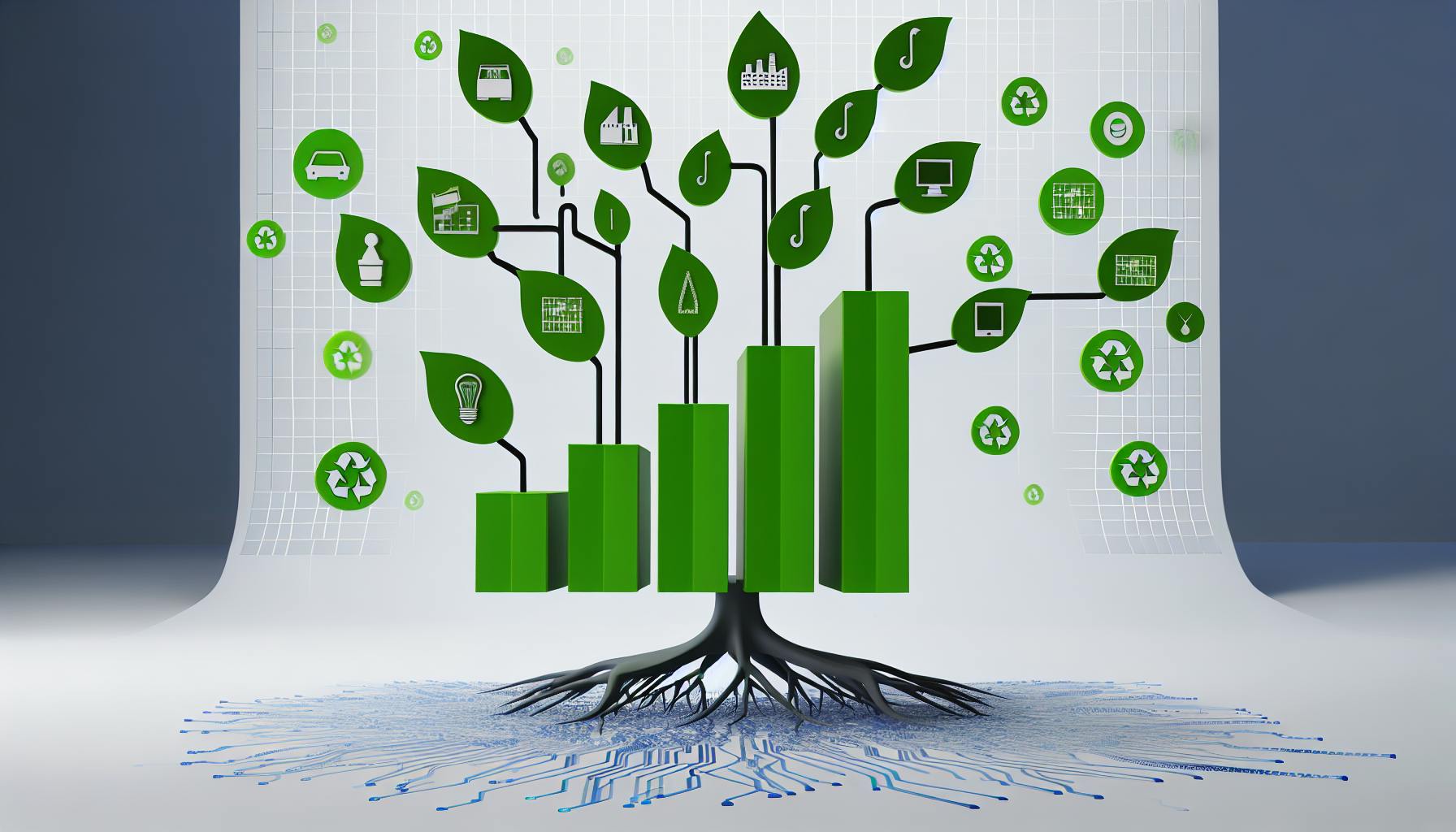Most SMEs would agree that understanding and reducing their carbon footprint is important, but the path to actually calculating and lowering emissions can seem daunting. Not to worry! There are straightforward activities any small business can implement to effectively measure and reduce their carbon impact.
In this practical guide, you'll discover simplified carbon accounting methods for SMEs, identify major sources of emissions, and learn about concrete mitigation activities across operations, supply chains, facilities and more. We'll also explore setting science-based targets, utilising carbon credits, and effectively communicating your carbon footprint achievements - all while keeping costs low and engaging your team.
Strategies for SMEs to Tackle Their Carbon Footprint
Measuring and reducing a business's carbon footprint is crucial for SMEs focused on sustainability. Tracking emissions enables cost savings, reputational benefits, and environmental impact reduction. This article outlines key activities SMEs can implement to calculate and lower their footprint.
Understanding the Carbon Footprint of Your Business
A carbon footprint measures the total greenhouse gas (GHG) emissions caused directly and indirectly by an organisation's activities. For SMEs, the largest sources often include energy use, transportation, supply chain processes, and waste.
Tracking emissions is important for several reasons:
- Cost Savings: Identifying the largest sources of emissions allows SMEs to implement targeted reduction strategies, like energy efficiency upgrades, that can significantly cut expenses.
- Reputation & Competitiveness: Demonstrating sustainability efforts appeals to environmentally-conscious investors, customers, and talent. This can improve public perception, retention, and market share.
- Environmental Impact: While SME contributions seem small individually, collective action is crucial to meet global climate goals and reduce environmental damage.
Simplified Carbon Footprint Calculation for SMEs
SMEs can follow these key steps to measure their carbon footprint:
- Define boundaries: Determine which business operations, subsidiaries, and value chain activities to include.
- Identify emission sources: Catalog major sources like facilities, transportation, purchasing, waste, etc.
- Collect activity data: Record energy use, fuel consumption, kilometres travelled, and other relevant data for each source.
- Apply emissions factors: Multiply activity data by published emissions factors to calculate GHG emissions.
- Track and report: Use carbon accounting software to systematically track emissions over time and generate reports.
Following consistent carbon accounting standards like the GHG Protocol ensures emission calculations are accurate and comparable across businesses. Over time, SMEs can identify the most impactful reduction opportunities.
What are the activities that contribute to carbon footprint?
Contributions to Carbon Footprint The major contributors to carbon footprints are: food, consumption, transportation, and household energy.
Food
The production, processing, transport and storage of food contributes significantly to carbon emissions. Choosing locally sourced, seasonal produce can help reduce emissions from transportation. Selecting plant-based proteins over meat and dairy also lowers the carbon footprint of meals.
Consumption
The manufacturing of products and their shipping contributes to emissions. Making sustainable purchasing choices by buying less, buying used and durable goods, and recycling helps diminish this impact.
Transportation
Transportation including driving personal vehicles, flying, shipping freight all release substantial CO2. Walking, biking, public transport, carpooling and limiting unnecessary travel mitigate transportation emissions.
Household Energy
Heating and cooling homes, running appliances and lighting rooms burn fossil fuels and emit carbon. Installing insulation, energy efficient systems, and using renewable energy helps curb energy-related emissions.
Small everyday choices related to what we eat, buy, how we travel and power our homes compound over time to comprise our carbon footprints. Increased awareness and minor habit changes in these areas can effectively reduce emissions.
What is my carbon footprint activity?
Our daily activities like using electricity, driving, flying, and throwing away waste all release greenhouse gases that contribute to climate change. The total amount of these emissions caused by an individual or organisation is known as their "carbon footprint".
Here are some common carbon footprint activities to be aware of:
- Home Energy Use
Activities that consume electricity or burn fuels like natural gas in your home produce associated carbon emissions. Things like powering lights, appliances, heating/cooling systems, cooking, and hot water all have a climate impact. Simple actions like turning off unused lights, adjusting your thermostat, and upgrading to energy efficient appliances can reduce your home's carbon footprint.
- Transportation
Driving personal vehicles running on gasoline or diesel is a major contributor to individual carbon footprints. Other transport like trains, buses, and flights also burn fossil fuels and emit greenhouse gases. Trying public transit, walking, biking, carpooling with others, or switching to an electric/hybrid vehicle are great ways to shrink your mobility footprint.
- Food and Goods
The production, packaging, transport and disposal of the products we buy and consume generates CO2 and other emissions. Choosing local, seasonal or organic foods, cutting food waste, and reducing consumption of meat and imported goods can significantly lower this impact area.
- Waste Disposal
Landfilling and incineration of household waste like plastics, paper, electronics and food scraps produces methane and other greenhouse gases. Properly sorting your recycling and compost, donating used goods, and avoiding excess packaging and single-use items helps minimise waste emissions.
Tracking your lifestyle's carbon footprint can reveal the activities most responsible for your climate impact. This allows you to focus efforts on targeted changes that reduce emissions for a greener footprint.
What activity has the highest carbon footprint?
The largest source of greenhouse gas emissions from human activities in the United States is from burning fossil fuels for electricity, heat, and transportation. Some key activities that contribute significantly to carbon footprints include:
Transportation
- Driving gasoline-powered vehicles, especially for long distances or with low fuel efficiency, produces substantial CO2 emissions that can account for over half of a household's carbon footprint.
- Air travel has an exceptionally high carbon footprint per passenger due to the large amounts of jet fuel burned. One round-trip transatlantic flight can emit over 1 ton of CO2 per economy class passenger.
Home Energy Use
- Heating and cooling homes with natural gas, heating oil, or other fossil fuels leads to considerable carbon emissions over time. Larger homes require more energy for climate control.
- Daily electricity usage for appliances, lighting, and electronics also indirectly produces greenhouse gases from fossil fuels burned at power plants. The more devices used and the less efficient they are, the larger this portion of a home's energy footprint becomes.
Food Production & Consumption
- Meat production, especially beef and lamb, has an exceptionally high carbon footprint due to methane emissions from cattle digestion, deforestation for grazing, and fossil fuels used to grow and transport feed crops.
- Food waste in landfills generates methane. About 30-40% of food in the U.S. goes uneaten, carrying the emissions from producing it without providing nutrition.
Transitioning these activities to low-carbon alternatives can significantly reduce emissions. Using public transportation, improving home efficiency, installing solar panels, buying local produce, and reducing food waste are practical steps individuals can take to lower their carbon footprint.
What set of activities will likely reduce carbon footprints?
Here are some practical activities that can help reduce carbon footprints for small and medium-sized enterprises (SMEs):
Switch to renewable energy
- Install solar panels or wind turbines to power business operations
- Source electricity from renewable energy providers
- This reduces reliance on fossil fuels like coal and gas
Improve energy efficiency
- Upgrade to ENERGY STAR certified appliances and equipment
- Install smart lighting systems and thermostats
- Ensure regular maintenance of HVAC systems
- Implement employee energy-saving practices
Reduce business travel
- Replace in-person meetings with video conferencing
- Organise carpools for necessary trips
- Fly economy class and choose direct flights to cut emissions
Offer sustainable commuting options
- Provide subsidies for public transport use
- Install EV charging stations for electric vehicles
- Encourage walking, biking, carpooling or public transport
Purchase carbon offsets
- Offset unavoidable emissions by purchasing verified carbon credits
- Support renewable energy, forest conservation and similar projects
Engage employees
- Encourage sustainable behaviours through workplace initiatives
- Organise tree planting drives and clean-ups
- Reward sustainability achievements
Small, consistent changes in daily business activities can significantly reduce an SME's carbon footprint over time. Automated carbon accounting software like EcoHedge provides tracking and insights to enable progress.
Greenhouse Gases and Carbon Footprints: Identifying Sources within SME Operations
SMEs generate carbon emissions from various business operations and activities. By analysing these sources, companies can identify opportunities to reduce their carbon footprint.
Reducing CO2 Emissions from Employee Commutes
- Encourage employees to use public transportation by providing commuter benefits or subsidies. This reduces single-occupancy vehicle trips.
- Promote carpooling and ride-sharing programs to minimise individual car trips. Designate priority parking for carpool vehicles.
- Support remote work and flexible scheduling when possible to limit commuting trips.
- Incentivise walking, biking, or using electric vehicles for commuting through rewards programs or facilities like bike racks, showers, and EV charging stations.
Carbon Footprints in Supply Chains and Procurement
- Calculate emissions from manufacturing, transporting, and disposing of purchased products and services.
- Engage suppliers on sustainability efforts and incentives for reducing carbon footprints.
- Source locally to shorten transport distances. Prioritise green suppliers with carbon-neutral shipping.
- Reduce business travel via virtual meetings. Choose sustainable aviation, rental car, and hospitality options when travel is essential.
Energy Management: Cutting CO2 Emissions in Facilities
- Conduct energy audits to identify efficiency opportunities like LED lighting, smart thermostats, and upgraded HVAC systems.
- Switch to renewable energy sources, install solar panels or wind turbines, or purchase renewable energy credits.
- Improve insulation, windows, doors, etc. to minimise heat and cooling loss.
- Install smart meters, sensors, and building automation systems to closely monitor energy usage.
- Educate employees on energy conservation best practices.
sbb-itb-0f1f828
Carbon Footprint Analysis: Setting Reduction Targets for SMEs
Establishing a baseline carbon footprint and setting concrete emissions reduction targets are critical first steps for SMEs aiming to reduce their climate impact. By quantifying current emissions across scopes 1, 2, and 3, companies can identify major sources of CO2 and track progress against science-based climate goals over time.
Choosing the Right CO2 Reduction Goals and Timelines
When setting carbon reduction targets, SMEs should consider:
- Current emissions footprint across direct operations, electricity use, and supply chain
- Reduction potential based on planned operational changes
- Industry benchmarks and best practices
- Alignment with 1.5°C trajectories endorsed by climate science
Aim for at least 50% absolute emissions cuts by 2030, and net-zero by 2050. Set interim milestones every 5 years. Focus initial efforts on high-impact areas like travel, shipping, and energy.
Engaging Leadership in the Carbon Footprint Activity
Getting buy-in from senior management is vital for carbon reduction success. Useful tactics include:
- Connecting sustainability to cost savings from efficiency gains
- Emphasising reputational benefits among stakeholders
- Making leaders personally accountable for emissions goals
- Having cross-functional teams co-develop climate roadmaps
With C-suite support tied to concrete climate action plans, SMEs can make rapid, organisation-wide cuts to their CO2 footprint.
Daily Activities to Lower SME Carbon Footprints
Outline specific initiatives across business operations SMEs can roll out to decrease their greenhouse gas emissions.
Promoting Sustainable Commute Options Among Employees
- Encourage employees to walk, bike, carpool or take public transport to work through corporate challenges and incentives. Offer rewards to teams and individuals with the lowest commuting emissions.
- Provide subsidies for public transport passes and bike purchases. Consider pre-tax payroll deductions to make it more affordable.
- Allow flexible work arrangements so employees can avoid rush hour commutes. Options include shifting hours, working remotely certain days, or compressed 4-day work weeks.
- Educate staff on sustainability through seminars on the environmental impact of commuting. Share tips to reduce their carbon footprint like trip planning and proper vehicle maintenance.
- Install bike racks, showers, and lockers to facilitate cycling to work. Guarantee rideshare parking spots to motivate carpooling.
Implementing Energy Efficiency Retrofits
- Upgrade to ENERGY STAR certified lighting and HVAC systems which use less electricity. Smart lighting solutions allow automated scheduling.
- Improve wall, roof and pipe insulation to prevent heat loss. Strategically use shades, awnings and landscaping to regulate building temperatures.
- Install solar panels, wind turbines or geoexchange systems to utilise renewable energy. Modern heat pumps leverage ambient warmth for heating needs.
- Switch to Energy Attribute Certificates if unable to generate clean power on-site. These fund renewable energy projects to offset non-renewable power usage.
- Track energy consumption through smart meters to identify optimisation areas. Maintain equipment well to prevent efficiency losses over time.
Balancing Emissions with Carbon Credits and Nature-Based Solutions
Explain how investing in certified carbon offset projects can counterbalance unavoidable emissions as part of a comprehensive climate strategy.
Exploring the World of Carbon Credits for SMEs
Carbon credits represent investments in projects that reduce, avoid, or remove greenhouse gas emissions. They act as a way for companies to offset their own unavoidable emissions. There are two main types of projects that generate carbon credits:
- Renewable energy projects like wind farms or solar installations that displace fossil fuel-based power generation. These projects reduce future emissions.
- Nature-based solutions like reforestation that remove carbon dioxide from the atmosphere through photosynthesis. These projects take past emissions out of the air.
High quality carbon credits follow standards that ensure the emissions reductions are real, measurable, permanent, and additional. Additionality means that the project only happened because of the revenue from selling credits.
Popular standards for certifying carbon credits include Gold Standard and Verified Carbon Standard (VCS). The types of projects available range from forest conservation in developing countries to methane capture on dairy farms.
SMEs can purchase credits voluntarily to make their operations carbon neutral. The credits counterbalance part of their carbon footprint from business travel, facilities, fleet vehicles or other activities. Offsets let companies take responsibility for emissions they cannot yet reduce internally.
Criteria for Effective Nature-Based Carbon Offsets
When evaluating potential nature-based carbon offsets, SMEs should look for projects that meet several key criteria:
- Additionality: The conservation would not happen without the funding from selling credits. There must be a real threat to the land and clear benefits to wildlife and local communities.
- Permanence: Protections are put in place like conservation easements to prevent future deforestation over the long term.
- Verifiability: There is ongoing monitoring, reporting and independent verification to confirm that carbon remains stored.
- Co-benefits: The project provides additional ecological, social or economic benefits beyond just carbon storage through biodiversity protection and community development.
Trustworthy standards like the Verified Carbon Standard have methodologies to ensure offsets meet these conditions. Investing in high-quality nature-based offsets supports sustainable land use globally while balancing out local emissions.
Communicating Your Carbon Footprint Journey to Stakeholders
Discuss best practices for tracking ongoing footprint reductions and sustainability initiatives and effectively conveying performance to stakeholders.
Utilising Carbon Footprint Calculators for Transparent Reporting
Carbon footprint calculators provide a standardised way to measure and track your organisation's CO2 emissions over time. Using an automated tool integrates emissions data collection into your business processes, ensuring consistency year-over-year.
Leading calculators align with major reporting frameworks like the Greenhouse Gas Protocol, making it easy to benchmark and compare your footprint against industry averages. Tracking emissions across Scopes 1, 2, and 3 gives a comprehensive view of your total climate impact.
Regular reporting provides the transparency needed to showcase progress to stakeholders. This builds trust and demonstrates commitment to emissions reductions goals.
Marketing Your Carbon Footprint Achievements
Effectively communicating sustainability initiatives is key to stakeholder engagement. Consider developing a sustainability section on your website that touts carbon lowering achievements through an interactive emissions dashboard.
Share success stories on social media highlighting activities like:
- Transitioning to renewable energy
- Implementing energy efficiency retrofits
- Changing business travel policies
- Developing eco-friendly products
Infographics also visually showcase footprint reductions in an easily digestible format for stakeholders.
Ultimately, marketing carbon achievements conveys your dedication to sustainable operations. This further motivates stakeholders to support emissions reductions efforts.
Engaging with the Community: Earth Day and Beyond
Encourage SMEs to participate in community events like Earth Day by organising carbon footprint educational activities and challenges.
Our Earth: Carbon Footprint Scavenger Hunt for SMEs
A scavenger hunt can be a fun and interactive way for SMEs to educate employees and community members on carbon footprints. Here are some ideas for setting one up:
- Create stations around the office/neighbourhood with clues leading to the next station. At each station, provide a fact, statistic, or challenge related to an everyday activity's impact on carbon emissions. Examples:
- Station 1: In the breakroom. Fact - Making a cup of tea has a carbon footprint of about 0.04kg CO2e from boiling the water.
- Station 2: At the printers. Challenge - Estimate how many sheets of paper your team prints in a day. Multiply by 0.017kg CO2e per sheet to get your footprint.
- Have small prizes at some stations for employees who answer correctly. This could be sustainable swag or gift cards to eco-friendly businesses.
- Conclude at a final station with pledges people can make to reduce emissions. Provide Carbon Footprint Calculators to help them estimate their entire footprint.
Making sustainability fun through games connects people more emotionally to the issues at stake. The scavenger hunt format also serves as an interactive educational tool to showcase the impact of daily activities.
Creating a Carbon Footprint Word Search Puzzle for Engagement
Word search puzzles related to carbon footprints can educate people on relevant terminology while allowing them to engage actively. Here are some tips:
- Include 15-20 words scattered randomly throughout the puzzle like "emissions," "sequestration," "renewables," "biofuels," "commuting," "teleconferencing," etc.
- Next to the puzzle, provide a word bank so people can reference terms.
- On the back, include a short informational paragraph on each term, explaining concepts for continued learning.
- Make some word searches complex (small font, more words) for staff members. Simplify others for community members by using larger text and fewer words.
- Consider handing out puzzles at Earth Day booths, schools, or libraries so people can learn by playing.
- Share an online editable version so people can create their own puzzles and test their knowledge.
Puzzles create mental associations between sustainability concepts and positive emotions. Allowing customisation also gives people autonomy in directing their learning experience. Gamification through word searches can encourage voluntary education and awareness building on carbon footprints.
Conclusion: The Path to Carbon Neutrality for SMEs
Summarising Carbon Footprint Activities and Their Impact
Reducing your carbon footprint can seem daunting, but breaking it down into practical activities makes it more achievable. Here's a recap of key takeaways:
- Calculate your baseline emissions using a carbon accounting tool. This allows you to identify your largest emission sources and set appropriate reduction targets.
- Switch to renewable energy sources like solar or wind to dramatically cut emissions from electricity use. This can yield some of the fastest, most impactful cuts. The latest available grant funding in the UK to help businesses with installing solar panels can be found here.
- Improve transportation efficiency through carpooling, public transport, EVs, route optimisation, etc. Transportation is often a major contributor to SME carbon footprints.
- Reduce business travel by substituting virtual meetings where possible. Each roundtrip flight can add over 1 tonne of CO2.
- Engage employees in workplace sustainability initiatives like recycling programs and behavioural change campaigns. Their actions can significantly influence your footprint.
- Offset remaining emissions by supporting certified carbon removal projects. Combining reductions with offsets enables carbon neutrality.
Tracking the progress of these activities shows their tangible impact towards reaching your emissions targets over time.
Continuing the Commitment to Reducing Your Own Carbon Footprint
Becoming carbon neutral is an ongoing journey that requires long-term commitment. But each step brings you one mile closer to the finish line. As you monitor footprint trends, continue expanding initiatives that work while correcting those that don't. Seek expert guidance tailored to your unique business needs and processes.
Most importantly, lead by example to inspire other SMEs that reducing emissions is an achievable business imperative with practical solutions readily available. Each small business acting today brings us closer to a sustainable, net zero economy tomorrow.



.png)


